Papaya is the tropical fruit Carica Papaya L. It belongs to the Caricaceae family and offers an excellent opportunity for agricultural enthusiasts due to its fast growth, high yield potential, and increasing demand in both local and international markets.
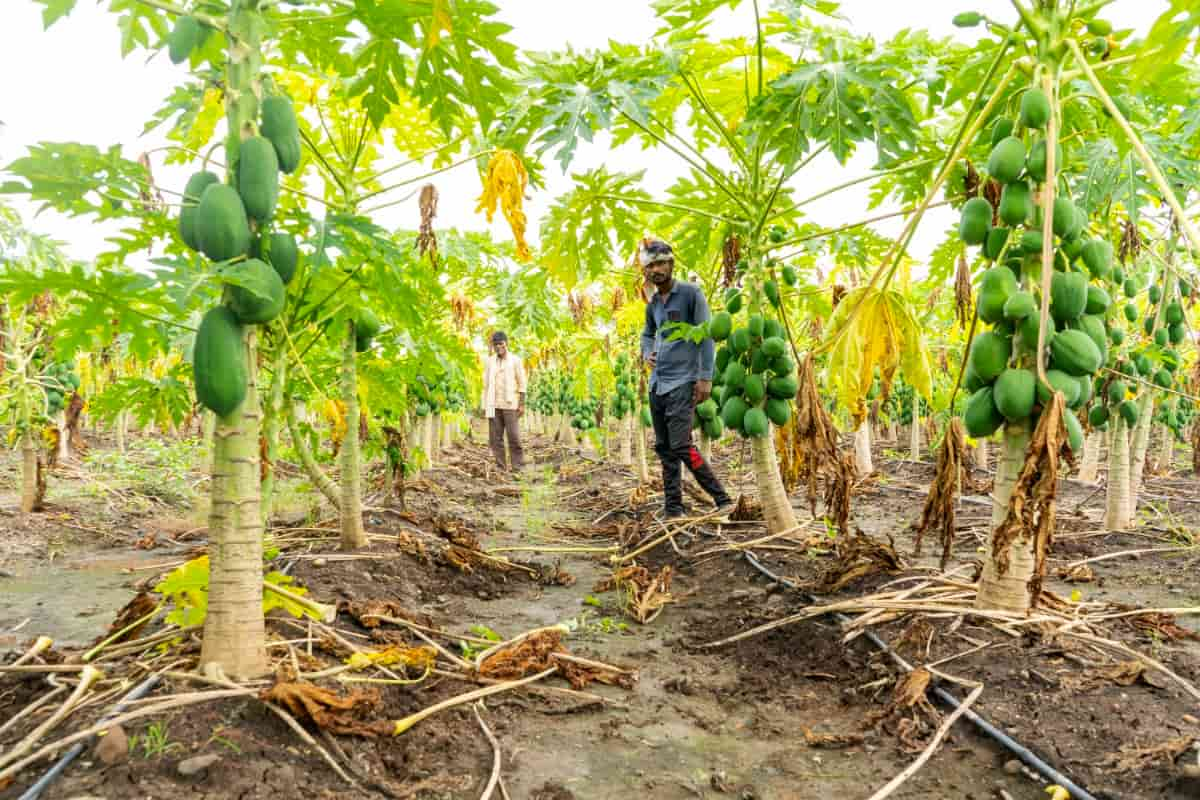
Selecting the Right Variety
Several factors should be considered when selecting Papaya varieties for farming, including climate, soil conditions, disease resistance, and market demand. Before choosing a variety, it’s essential to assess your specific farming conditions and market preferences to ensure the best possible yield and quality.
Certain varieties may be more popular among consumers due to their taste, size, or shelf life. It’s essential to grow a variety that has good market potential. The important varieties are Red Lady, Maradol, Tainung #1, Sunrise Solo, Hawaiian, Caribbean Red, Coorg Honey Dew, Golden Papaya, Waimanalo, and Kapoho.
Climate and Soil Requirements
Papayas thrive in tropical and subtropical climates with temperatures around 21-32°C. For optimal growth, they require well-drained, sandy loam soil rich in organic matter. Papayas are sensitive to frost and strong winds, so planting them in a sheltered location is recommended. The ideal pH level for Papaya cultivation ranges from 5.5 to 7. To ensure healthy growth, monitor the temperature and humidity levels regularly.
Preparing the Land
Before starting your Papaya farm, it’s essential to prepare the land properly. Begin by clearing the area of any debris or weeds that could hinder growth. Make sure the soil is rich in organic matter to provide optimal conditions for Papaya plants.
In case you missed it: Honey Dew Papaya Farming in India: How to Start, Care, Pest, and Disease Management
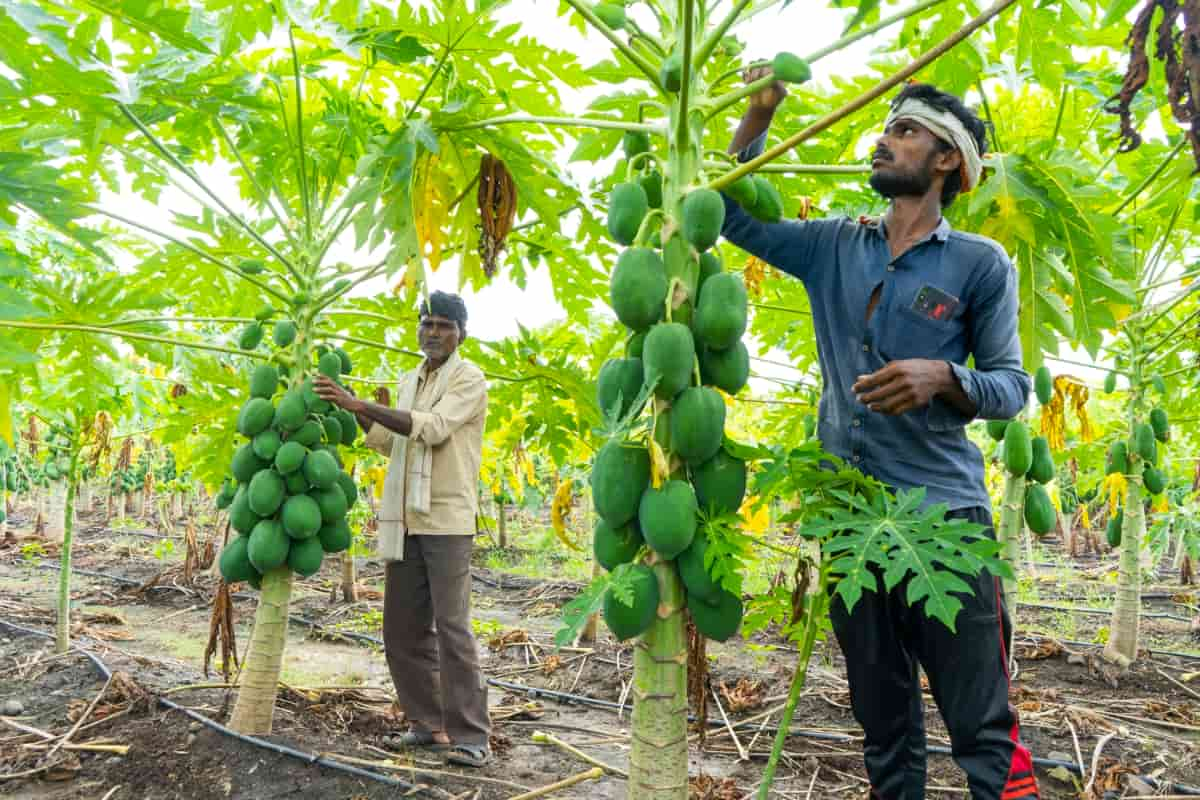
Consider making a soil test to determine if any amendments are needed before planting. This will ensure that your Papayas have access to the nutrients for healthy growth. Plowing or tilling the land can help improve soil structure and aeration, promoting root development. Papayas thrive in warm climates with plenty of sun, so selecting a sunny spot is crucial for their success.
Planting Techniques
Start by selecting healthy seedlings from a reputable source. Make holes twice as wide and deep as the seedling’s root ball. After preparing the soil with compost and organic matter, gently place the seedlings in the hole and backfill with the soil. Ensure that the plant is positioned at ground level to prevent rotting or waterlogging.
Water thoroughly after planting to help establish root growth. Mulch around the base of the plant to retain moisture and suppress weeds. Papayas thrive in warm climates, so select a sunny place with well-draining soil for optimal growth. Monitor your Papaya plants regularly for signs of stress or nutrient deficiencies. Proper spacing between plants is essential for good air circulation and sunlight exposure.
Drip Irrigation Management
Drip irrigation is an essential component of successful Papaya farming. It involves delivering water directly to the plant’s roots, so they receive the right amount of moisture. This method helps conserve water and prevents wastage by reducing evaporation. By using drip irrigation, farmers can control the timing and quantity of water provided to their Papaya plants, optimizing growth and fruit production.
Proper maintenance of drip irrigation systems is crucial for efficient operation. Adjusting the system according to weather conditions and plant needs will help maximize its benefits. Implementing a well-managed drip irrigation system in your Papaya farm can lead to healthier plants, increased yields, and cost-effective resource use.
Fertilization Strategies
Fertilization is a crucial aspect of Papaya farming, ensuring the plants have the necessary nutrients to thrive and produce high-quality fruits. When it comes to fertilization strategies, it’s essential to consider both organic and inorganic options. Organic fertilizers can help improve soil fertility over time.
In case you missed it: Red Lady Taiwan Papaya Farming in India: How to Start, Yield, Care, and Management
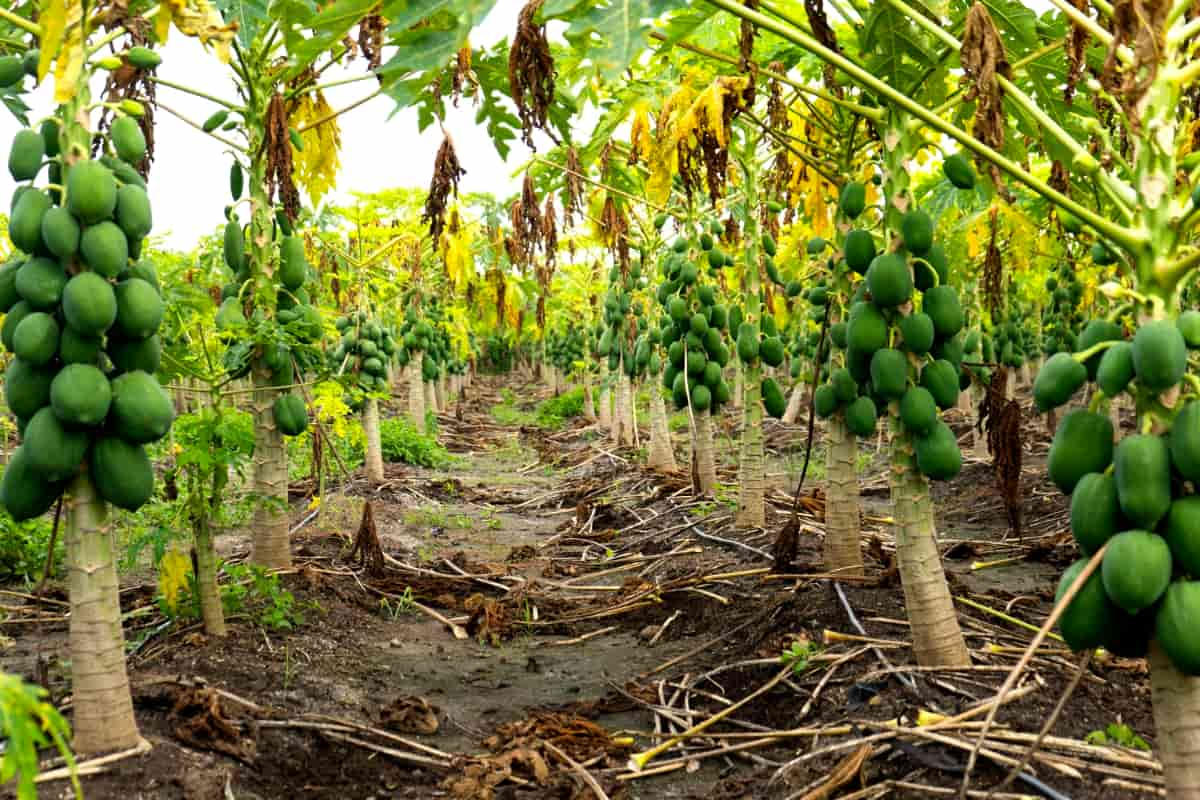
On the other hand, inorganic fertilizers provide a quick boost of essential nutrients like nitrogen, phosphorus, and potassium. Applying fertilizers at specific growth stages of Papaya plants is also critical for optimal results. For example, providing a balanced mix during flowering can enhance fruit set and development.
Pest and Disease Control
Pests and diseases can be a major problem for Papaya farmers, affecting the growth and quality of the fruit. To keep these nuisances at bay, implementing effective pest and disease control measures is crucial. The common pest that attacks Papaya plants is the Papaya fruit fly. To combat this, traps and biological controls like parasitic wasps can help reduce their population.
Another threat to Papayas is powdery mildew, a fungal disease that appears as white patches on leaves. Regularly inspecting plants for signs of infection and applying fungicides when necessary can prevent its spread. In addition to pests and diseases, proper sanitation practices such as removing diseased plant material can also help in preventing future infestations.
Weed Management
Weed management is a crucial aspect of Papaya farming to ensure the healthy growth and development of your plants. Weeds compete with Papaya trees for nutrients, water, and sunlight, hindering their growth if left unchecked. Implementing mulching techniques can help suppress weed growth around your Papaya plants. Organic mulches not only deter weeds but also retain moisture in the soil.
Regular manual weeding is necessary to remove any persistent weeds that pop up near your Papaya trees. Consider using herbicides sparingly, as they can potentially harm your Papaya trees if not applied correctly. Always follow recommended guidelines when using chemical weed control methods on your farm.
Growth Monitoring and Care
Growth monitoring is essential for ensuring healthy plant development in Papaya farming. Regularly inspecting the Papaya plants for signs of nutrient deficiencies or pests can help prevent potential issues. Keeping a close eye on the growth rate and overall health of the Papaya plants allows farmers to intervene promptly if needed.
In case you missed it: How this Farmer Earning 30 Lakhs from Papaya Cultivation in 6 Acres: An Indian Farmer Success Story
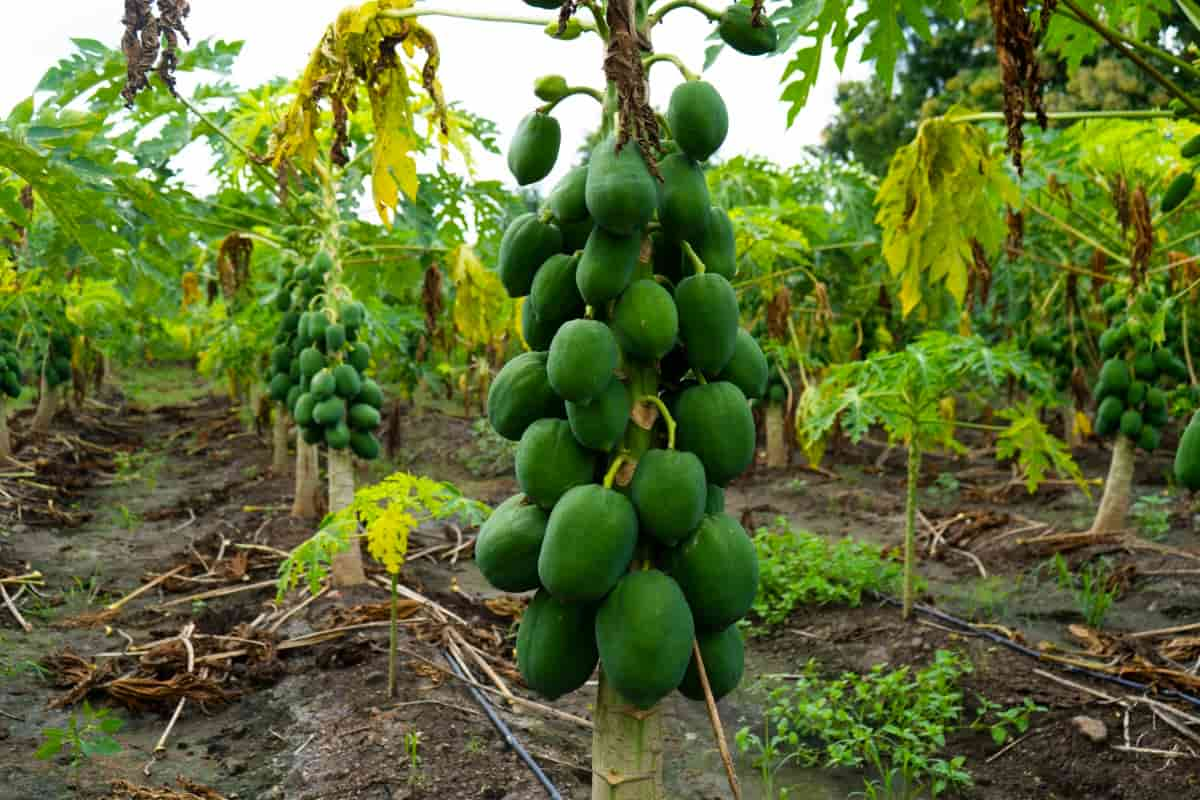
Careful attention should be paid to water management, as Papayas require consistent moisture levels to thrive. Proper irrigation techniques ensure that the plants receive adequate hydration without being overwatered. Additionally, providing sufficient sunlight and maintaining proper spacing between plants contributes to optimal growth.
Flowering and Pollination
When it comes to flowering, timing is everything. Papaya plants typically start flowering within 4-6 months after planting, with the first flowers being male. These male flowers help attract pollinators like bees to transfer pollen to the female flowers. Ensuring proper pollination is key for a successful fruit set. Since Papayas have separate male and female plants, having a good ratio of both is important for optimal pollination.
You can also manually assist by gently shaking the plants or using a brush to transfer pollen between flowers. Weather conditions can also impact flower production and pollination success. Be mindful of temperature fluctuations and ensure adequate moisture levels to support healthy flower development.
Tips To Boost Flowering
Ensure your Papaya trees receive adequate sunlight. Position them in a spot where they can soak up plenty of natural light throughout the day. Consider applying a balanced fertilizer with higher potassium levels during the flowering stage. This nutrient is crucial for promoting healthy flower development.
Additionally, regular pruning can help stimulate new growth and encourage more flowers to bloom. Remove any damaged branches to allow for better air circulation around the plant. Moreover, maintaining consistent watering practices is essential. Keep the soil moist but not waterlogged to support optimal flowering conditions for your Papayas. Consider using organic supplements like compost or manure to provide nutrients that can help boost flower production naturally.
Fruit Development and Ripening
Once the Papaya flowers have been successfully pollinated, the small fruits begin to develop. As they grow, you’ll notice the green color start to change into a vibrant yellow or orange hue, depending on the variety. This transformation indicates that the fruit is ripening and nearing harvest time.
In case you missed it: Best Fertilizers for Papaya Trees
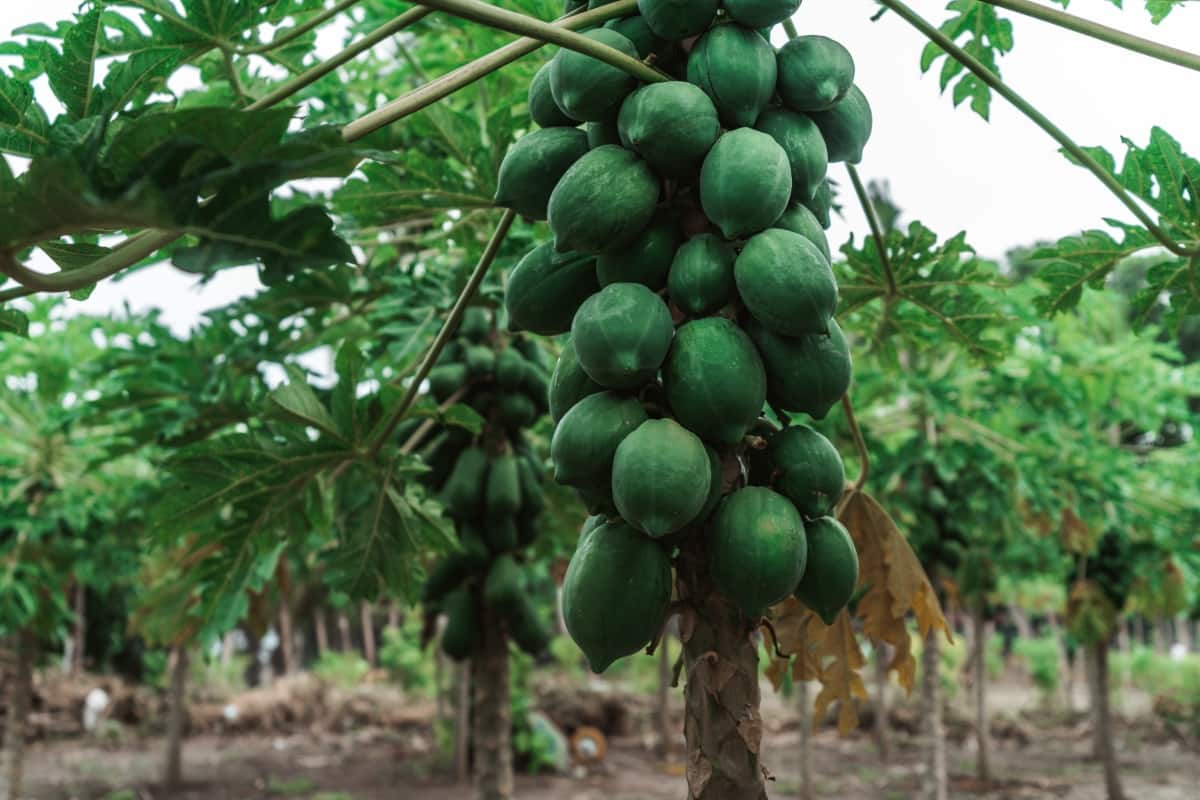
During this phase, it’s crucial to monitor the Papayas closely to ensure they reach optimal ripeness. A gentle press near the stem should indicate a slight give without being too soft – a sign that it’s ready for picking. Avoid waiting too long, as overripe Papayas can become mushy and lose their flavor. Harvesting at just the right moment ensures that your Papayas are flavorful and have a desirable texture when consumed. Time your harvest carefully based on visual cues and tactile feedback from gently testing each fruit’s readiness.
Harvesting Techniques
Harvesting Papayas at the right time is crucial for their quality and taste. The best indicator of ripeness is when the fruit turns yellow or orange, depending on the variety. To harvest, gently twist the fruit until it breaks off from the tree, ensuring you don’t damage the stem. Avoid picking unripe Papayas, as they won’t ripen after harvesting.
Harvest early in the morning when temperatures are cooler to prevent heat stress on the fruits. Use sharp tools to cut through stems instead of pulling them off, reducing potential damage. Handle harvested Papayas with care to avoid bruises or cuts that can impact shelf life. If not immediately processed or sold, store them in a cool and dry place. Proper handling post-harvest ensures that your Papayas reach consumers fresh and delicious.
Expected Yield
The yield of Papayas can vary depending on various factors such as the variety chosen, climatic conditions, soil quality, and proper care throughout the growth stages. On average, a single Papaya tree can produce anywhere from 50 to 100 fruits per year once it reaches maturity. However, this number can fluctuate based on how well you maintain your farm and provide adequate nutrients and water to the plants.
Post-Harvest Handling and Storage
After the Papayas are harvested, proper post-harvest handling is essential to extend shelf life. The important step is to handle the fruits carefully to avoid bruising or damage. Papayas should be sorted based on maturity and size before moving on to storage. To ensure optimal freshness, it’s recommended to store Papayas in a cool, well-ventilated area away from direct sunlight. The ideal temperature for storing ripe Papayas is around 10-12°C.
In case you missed it: Top 20 Steps to Boost Papaya Yield: How to Increase Fruit Size, and Production
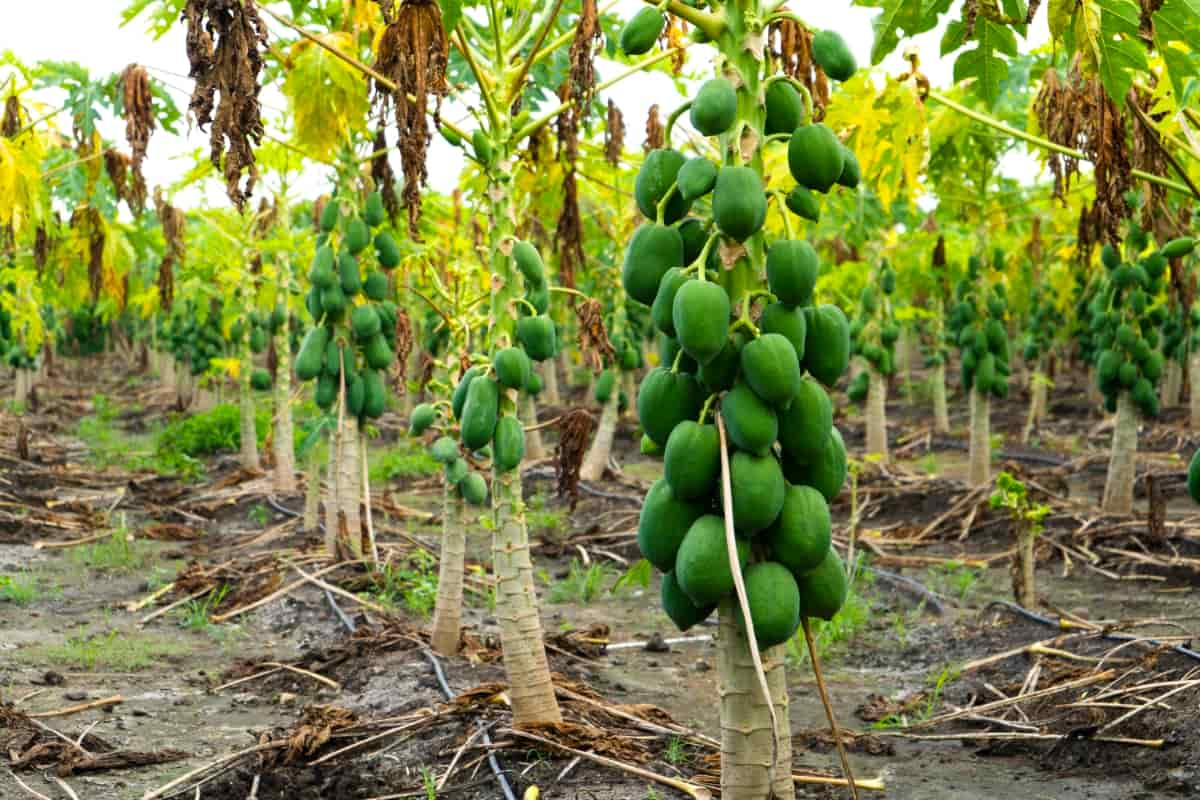
Additionally, maintaining relative humidity levels between 85-90% can help prevent dehydration of the fruits. Proper packaging plays a major role in preserving the quality of Papayas during storage and transportation. Using breathable packaging materials like perforated plastic bags can help reduce moisture buildup while still allowing for adequate air circulation.
Regularly inspecting stored Papayas for signs of spoilage or rotting is necessary to remove any affected fruits and prevent further contamination. Implementing good sanitation practices in storage areas can also help minimize the risk of mold growth and decay among stored Papaya batches.
Marketing and Selling Papayas
The effective strategy is to establish partnerships with local grocery stores, markets, or restaurants that value fresh produce. Another approach is to utilize social media platforms and online marketplaces to promote your Papayas directly to consumers. Creating engaging content, sharing recipes featuring Papayas, and offering special promotions can help generate interest in your product and attract new customers.
Additionally, participating in farmer’s markets or agricultural fairs can provide a good opportunity to connect with customers face-to-face and educate them about the benefits of consuming locally grown Papayas. Building a strong brand presence and reputation for delivering high-quality fruits will set you apart from competitors in the market.
Challenges and Solutions in Papaya Farming
The common challenge faced by Papaya farmers is pest infestations, such as aphids and fruit flies, that can damage the crops. To combat this issue, integrated pest management strategies involving natural predators or organic pesticides are recommended. Another challenge in Papaya farming is disease outbreaks, such as powdery mildew, damping-off, or black spot disease.
Prevention measures, such as maintaining proper spacing between plants for good air circulation and regular monitoring for early signs of disease, are crucial to mitigate these risks. Unfavorable weather conditions, such as excessive rainfall or drought, can also impact Papaya production. Implementing efficient irrigation systems and providing adequate shelter during extreme weather events can help safeguard the crop’s health.
Market fluctuations and competition from imported Papayas pose marketing challenges for small-scale farmers. Building strong relationships with local markets or exploring export opportunities can help overcome these hurdles and ensure a steady income stream for growers. Being proactive, staying informed about best practices, and adapting to changing circumstances are key to navigating the challenges in Papaya farming successfully.
Papayas thrive in tropical and subtropical climates with warm temperatures, ample sunlight, and well-draining soil. By following these steps and adapting to your specific growing conditions, you can establish a successful Papaya farming.
- How to Make Houseplants Bushy: Effective Tips and Ideas
- Innovative Strategies for Boosting Coconut Pollination and Yield
- Pollination Strategies for Maximum Pumpkin Yield
- The Complete Guide to Chicken Fattening: Strategies for Maximum Growth
- Natural Solutions for Tulip Problems: 100% Effective Remedies for Leaf and Bulb-Related Issues
- Revolutionizing Citrus Preservation: Towards a Healthier, Greener Future
- Natural Solutions for Peony Leaf and Flower Problems: 100% Effective Remedies
- Maximizing Profits with Avocado Contract Farming in India: A Comprehensive Guide
- Natural Solutions for Hydrangea Problems: 100% Effective Remedies for Leaf and Flowers
- The Ultimate Guide to Choosing the Perfect Foliage Friend: Bringing Life Indoors
- From Sunlight to Sustainability: 15 Ways to Use Solar Technology in Agriculture
- The Ultimate Guide to Dong Tao Chicken: Exploring from History to Raising
- The Eco-Friendly Makeover: How to Convert Your Unused Swimming Pool into a Fish Pond
- Mastering the Art of Delaware Chicken Farming: Essentials for Healthy Backyard Flocks
- 20 Best Homemade Fertilizers for Money Plant: DIY Recipes and Application Methods
- How to Craft a Comprehensive Free-Range Chicken Farming Business Plan
- Brighten Your Flock: Raising Easter Egger Chickens for Beauty and Bounty
- How to Optimize Your Poultry Egg Farm Business Plan with These Strategies
- Subsidy for Spirulina Cultivation: How Indian Government Schemes Encouraging Spirulina Farmers
- Ultimate Guide to Raising Dominique Chickens: Breeding, Feeding, Egg-Production, and Care
- Mastering the Art of Raising Jersey Giant Chickens: Care, Feeding, and More
- Ultimate Guide to Raising Legbar Chickens: Breeding, Farming Practices, Diet, Egg-Production
- How to Raise Welsummer Chickens: A Comprehensive Guide for Beginners
- How to Protect Indoor Plants in Winter: A Comprehensive Guide
- Ultimate Guide to Grow Bag Gardening: Tips, Tricks, and Planting Ideas for Urban Gardeners
- Guide to Lotus Cultivation: How to Propagate, Plant, Grow, Care, Cost, and Profit
- Agriculture Drone Subsidy Scheme: Government Kisan Subsidy, License, and How to Apply Online
- Ultimate Guide to Raising Araucana Chickens: Breed Profile, Farming Economics, Diet, and Care
- Bringing Hydroponics to Classroom: Importance, Benefits of Learning for School Students
- Ultimate Guide to Raising Polish Chickens: Breed Profile, Farming Economics, Diet, and Care
- Ultimate Guide to Raising Australorp Chickens: Profile, Farming Economics, Egg Production, Diet, and Care
- Silkie Chicken Farming: Raising Practices, Varieties, Egg Production, Diet, and Care
- Sussex Chicken Farming: Raising Practices, Varieties, Egg Production, Diet and Care
- Homemade Feed Formulations for Livestock: Discover Cost-effective Starter to Finisher Feed Recipes
- 20 Best Pig Weight Gain Supplements: Top Swine Weight Gain Formulas
- Ultimate Guide to Elderberry Farming: Propagation, Planting, Yield, Cost, and Profit
I am confused about the yield. I read that the average yield in the country is 12 tons/acre/year.
You have mentioned maxoof 250 kg/year/acre. Which is right
Is pusa nanha varity is good for marketing purpose instead of red lady and if yes then can you give details about that varity
Me too confused with yield calculation. Could you please elaborate on the basis of yield per plant for each year, upto 3 years of plant life. This would be very helpful.
Thanks in advance…
Mohan, We will be updating high density papaya project report in couple weeks with yield information.
Whether we can get ready seedlings of papaya for plantation. Also is it possible to use 100% natural fertilizers.
Do you have any office or person who can explain papaya planting in detail. Also suggest soil and climate condition are suitable after visiting the site.
Many Good nurseries are providing varieties of Papaya seedlings. You can check on Nurserylive dot com as well. With natural fertilizers, good yield is not possible for commercial papaya farming. It also take more time to mature.
Patil just use Biostimlulants; these are natural fertilizers and plant systems stimulators and soil enhancers. they will do wonders in your papaya production.
Thank you.
Where can I buy Papaya seed in Tamilnadu?
You can visit any good nursery in Tamilnadu to procure high yielding or hybrid Papaya seeds.
Very happy to find your interesting web site. I’m planting papayas in Thailand, but suppose what works in India can be applied well here also.
On your https://www.agrifarming.in/papaya-farming/ page, you recommend ‘A fertilizer dose of 400g nitrogen, 250g phosphorous and 400g of potassium per plant per year should be applied in six split applications under irrigated conditions.’
Using a common N-P-K fertilizer formula like 15-15-15, this works out to over 2.5 kg of the granular fertilizer per year. Is that correct? It seems rather high.
Thanks for your advice.
Is papaya agriculture profitable in Utter Pradesh?
I would like to do papaya farming. I have one acre land in south India, where the climate is hot in Mangalore. Is it suitable for papaya farming and how much plants can I plant in one acre land and how much papaya it can produce per harvest. I would like to learn more if you can give me a course.
You can get some information about Papaya Cultivation here:Papaya Farming Project Report.
Which variety is best for punjab
which variety is best for ghaziabad utter pradesh.
Red Lady Papaya is good cultivar.
Sir, we have a land of hilly regions, & I am planning for papaya plantation in that place will it work or not?
Read this to understand soil, climate and areas to grow Papaya fruit. Papaya Farming Project Report.
What kind of soil is best for papaya cultivation. I have 10 Acre land but it has mix soil probably 50 percent sand and rest are clay etc. so in this soil can I cultivate papaya or not.
Papaya Needs to sandy soils with good drainage. Read complete project report: Here.
is it good to cultivate papaya in Kashmir for commercial purpose?
is it good to cultivate papaya in kashmir for commercial purpose
Best time in papaya farming in gujrat,kheda.
how to control male flowering of papaya
I want papaya farming in Moradabad district (UP) for commercial purpose,
Please guide me about this
Thank you very much for the knowledge giving on how to plant handle papaya farm, I have operated papaya farm since May 2022, that is about nine months ago but uptill day they have not done anything good, and there are about Ninety two trees of papaya in the farm, I understood that i have committed so many mistakes during the period of planting, So that is the root cause of the problem if my papaya farm, The papaya leaves have started turning into yello colour for the past two months and by now only ten trees of papaya started bearing fruits and the fruit per tree are not up to nine and sometimes some of the fruits on a plant used to turns yellow colour after some days the yellow fruit fall down.So this is what worries me alot.Please can you help me with a solution that can resque my papaya farm from collapsing? Thank you, please untill i hear from you. I am even planning to increase the size of my papaya farm to a complete one hectre but now the the small one i have is frustrating me.Thanks and good bye.
i want to papaya farming at ratangarh, rajasthan. can you please provide a contact number about guidance?